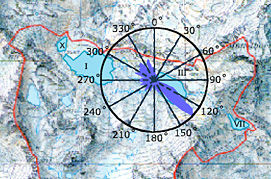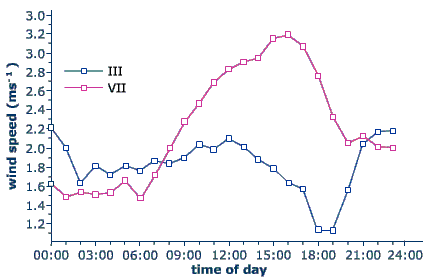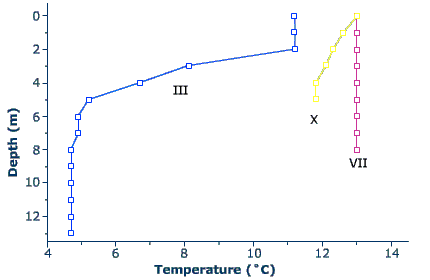 |
|
|
|
|
|
1 - View of Lake Jöri valley |
Direction, strength and frequency of winds influence lake stratification and temperature budgets. |
|
Wind direction |
|
|
In the Jöri catchment, main wind directions coincide with the axis of the valley. Lake Jöri VII situated on the Jöriflesspass is exposed to frequent winds from southeast. Lakes III and X, which lie in the Jöri valley, are more protected from strong winds by glacial moraines. Lake X lies in a protected dip at the northwest end of the valley. The temperature profiles in these lakes reflect local heat budgets and wind action. |
2 - Distribution of wind direction measured over a one year period with an automatic weather station situated near lake Jöri III. |
Wind speed |
|
|
In general, lake VII is affected by much stronger winds than lake III. Data for a typical fall day (September 1997) from automatic weather station located at lakes VII and III, show the different strength of winds over a one day period (data from Gabathuler 1999). |
3 - Data for a typical fall day (September 1997) |
Lake surface temperature | |
|
During a sunny day, all lakes increase surface temperature from 2° to 5° C. A temperature peak can be observed in lake III and X. Surface heating of lake VII is only moderate, due to stronger and more frequent winds, which mix the hole water body thus preventing distinct heat-up of the water surface layer. |
4 - Lake surface temperature peaks on a sunny day |
Lake temperature stratification | |
|
Temperature stratification develops in lakes III and X while lake VII, which is most strongly affected by winds, remains mixed to the bottom most of the time. |
5 - Temperature course on a representative day in August 98 demonstrate a typical stratification for lake III, VII and X. |
29 August 2011 |
||
| |
||




